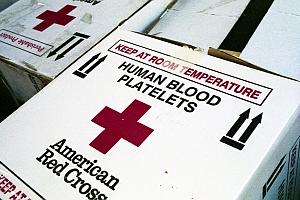8 September 2014. Biomedical engineers and medical researchers designed and tested in the lab a new type of synthetic particle that acts like natural blood platelets to help heal bleeding. The team from Georgia Institute of Technology and Emory University medical school, both in Atlanta, published its findings yesterday in the journal Nature Materials (paid subscription required).
Platelets are cells in the blood whose function is to stop bleeding from broken blood vessels. When platelets in the blood are working properly and at normal levels, they respond to signals of a damaged blood vessel from a protein known as thrombin and accumulate at the site forming a clot, which slows the blood flow. The clot forms by platelets depositing a natural polymer called fibrin at the point of damage, which changes the shape of the platelets and lets them clump together in a clot to staunch the blood flow.
The Georgia Tech/Emory team led by biomedical engineers Thomas Barker and Andrew Lyon developed tiny soft synthetic particles from a biocompatible hydrogel material, about 1 micron — 1 millionth of a meter — in diameter. The team designed the particles to respond to a bleeding episode in much the same way as a natural platelet, by accumulating the fibrin polymer at the spot of the blood vessel damage. To respond to the bleeding, the researchers attached to the hydrogel particles an antibody that attracts the fibrin enabling a clot to form.
The team tested the synthetic platelet particles in microfluidics — lab-on-a-chip — devices with channels to simulate blood vessels in a fresh wound, coated with cells found on the inside lining of natural blood vessels. When the synthetic particles were added to human blood low in platelets, the blood formed clots in the simulation devices, much like blood rich in platelets. The researchers report similar results in tests with lab animals.
Barker, Lyon, and colleagues conducted more proof-of-concept lab tests with the synthetic particles. One set of tests was conducted with blood from infants who had open-heart surgery, where their blood is diluted to improve blood flow and reduce clotting. In these tests, the particles helped the diluted infant blood form clots. Further tests with blood from hemophiliacs, who do not have fibrin in their blood to form clots, showed the synthetic particles did not, as predicted, form clots, since there was no fibrin to respond to the antibody attached to the particles.
The authors say the synthetic platelet particles still have more questions to answer, including how the body eliminates the particles, as well as their performance in human clinical trials. The particles were originally developed as a form of first-aid for wounded soldiers, who could even self-administer the particles on the battlefield. The researchers believe the particles could also reduce the need for transfusions for surgery or chemotherapy patients.
Read more:
- Cancer Screening Blood Test Proposed, New Company Formed
- Genetic Blood Transfusion Diagnostic Approved by FDA
- Blood Glucose Control Drug Approved for Type 2 Diabetes
- Engineered Cardiac Tissue Helps Veins Return Blood to Heart
- Process Devised to Generate Stem Cells from Drop of Blood
* * *


 RSS - Posts
RSS - Posts
You must be logged in to post a comment.